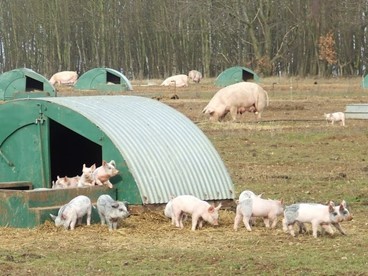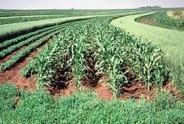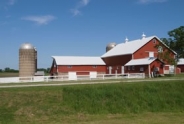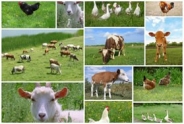Raising Pigs on Pasture: Lessons Learned from North Carolina
Amy Barkley, Team Leader & Livestock Specialist
Southwest New York Dairy, Livestock and Field Crops Program

Raising Pigs on Pasture: Lessons Learned from North Carolina
Amy Barkley, Livestock Specialist, SWNYDLFC
This past month, I traveled to the Carolina Meat Conference in Boone, NC. If you get the chance to attend, DO IT!!! It's such a cool experience learning about new and alternative livestock farming methods, how to process livestock through demonstrations, talking through education and policy, and learning from others' experiences. One of the topics that caught my interest this year was the pastured pig discussion. In WNY, I'm seeing an increase in the number of pigs raised on pasture or in the woods. This is an age-old practice, dating back to when the nation was first founded, and everyone had the family hog that was home-processed to help them get through the winter months. Some of the first research on the topic dates back to about 100 years ago, so the idea of raising a better pig in a pastured setting isn't something new. Lee, a farmer and NC Cooperative Extension educator living in the mountains in NW North Carolina, brought his 20 years' experience of raising pigs on pasture to a classroom setting. From that conversation, here are some points that resonated with me that you may find helpful to employ on your farm.
Pigs need a place to sleep safely, have their piglets safely, and get out of the sun: Many folks supply a man-made hoop-type structure for this purpose. In Lee's case, he got some old metal grain bins from a neighbor that he cut in half to create hoop structures. He added sides that have doors and windows while situating the structures to allow for natural ventilation. With deep bedding, he's able to keep pigs on pasture year-round, but with our frigid winters, we may not be able to get away with that in WNY! If using a structure with pasture access, be prepared to clean a whole lot of dried mud out following the wallowing season! Some other tips are:
- Design indoor areas to be 1/3 waste area, 1/3 feeding area, and 1/3 bedding area. With the proper stocking density, pigs naturally gravitate towards this division. The dedicated waste area allows for easy spot cleaning.
- When designing an in-structure feeding area that isn't mobile, a concrete area allows for easy cleaning, especially if it's sloped such that water runs off the slab to the outside of the building.
- Do not have drafts in buildings you're farrowing in, especially in the cold weather. Piglets are very susceptible to hyperthermia.
- Too much bedding in a hut designed for farrowing can result in the dam piling the bedding up and inadvertently laying on her piglets in the bowl she's created.
Wallow management is necessary: Pigs make wallows of mud to help them cool down, especially during summer. They don't sweat like we do, so evaporative cooling (ie the mud drying on their skin) is necessary. If not managed, these wallows can become multiple feet deep and cause your pasture to become a moonscape. So, Lee suggests the following:
- Create a wallow-specific area. If your pasture is sloped, select an area at the top of the slope, since wallowing areas at the bottom of slopes continuously fill with runoff and become unmanageable quickly.
- When there isn't enough rain to keep the wallow muddy, fill it with water to draw pigs' attention away from making a wallow near their watering area and to keep the wallow in useful condition.
- At the end of a grazing period, fill in the hole, reseed it, and then create a new wallow elsewhere. This helps limit the sprawl of the area and reduces the risks of people getting hurt or equipment being damaged from falling in.
- Have a shady spot with good airflow available for the pigs to hang out in once they're covered in mud. As the mud cakes and falls off, it'll leave a pile, so you will have to redistribute it once the pigs move off pasture.
Every pasture has walk lines and wear areas: Pigs tend to pace fence lines and have preferences for areas of the pasture, resulting in them wearing down (or digging up!) the grass in that area. Rotating pastures on an annual basis allows you an opportunity to resurface and reseed bare spots. Rotating more frequently gives you the chance to maintain forage cover and cause less soil disruption.
Feed pigs a ration balanced for pigs: While pasture provides enrichment, health benefits, and vitamin accumulation in the meat/fat, it isn't intended to provide a complete ration for pigs. For one, today's pigs aren't great foragers. Second, their efficiency and finished quality depends on a high protein, high fat diet. Third, grass doesn't provide enough nutrition for pigs, even if they're raised longer and/or if you provide high quality annual pasture plants like radish or millet. Research from the 30s - 50s indicates that they can glean some nutrition from forages, but not much. Providing a complete ration in addition to quality forage ensures that they will grow and perform as desired while also accumulating more concentrated nutrition in their meat.
In summary, pasturing pigs isn't as easy as letting them out in a pasture and letting them do their thing. There's quite a bit of management involved to ensure it's done well. If you have a market for pastured pork products and a desire to take advantage of the outcomes of pigs raised this way, go for it! If you need any assistance, please feel free to reach out to me, Amy Barkley at (716) 640-0844 or amb544@cornell.edu
Upcoming Events
Crops, Cows & Critters - Southwest New York Dairy, Livestock & Field Crops Newsletter Sponsorship
December 19, 2025
Our two forms of publications feature research-based and timely information from our four specialists, listed to the right, along with local event notifications and Cornell University outreach. This information is provided to participants who range from dairy, livestock, and field crops producers to agricultural suppliers and consultants.
Weekly Email Update: Shared with 625+ households who have signed up with our program.
Monthly Paper Mailer: To reach our stakeholders and farmers who lack internet access, we send out a monthly mailer where your company's logo and contact information would be featured with a mailing list of 330+ households.
If you sponsor our weekly and monthly publications you reach approximately 955 households.
Visit our website to view our newsletters!
2025 Cornell Food Beverage & Animal Feed Manufacturer Survey
December 19, 2025
Industry and Educational Advocates for New York State's Food, Beverage, and Animal Feed Manufacturing industries:
As you know, NYS has a diverse food and beverage manufacturing industry, in both the types of industries that exist and the wide distribution of firms by scale. Many manufacturing firms have strong backward linkages to agricultural production sectors in the state that support both farm-level and downstream food industry firms and consumers. In collaboration with the New York State Department of Agriculture and Markets, a team from Cornell University's Charles H. Dyson School of Applied Economics and Management has recently rolled out the 2025 New York State Food, Beverage, and Animal Feed Manufacturer Survey. The industry will benefit from an updated assessment of the industry that informs private and public investments and opportunities to support firm growth and improved profitability.
Boots in the Barn: Cornell Dairy Research Updates
January 13, 2026
January 20, 2026
January 27, 2026
February 3, 2026
February 10, 2026
February 17, 2026
February 24, 2026
Join us for some or all!
Announcements
No announcements at this time.





